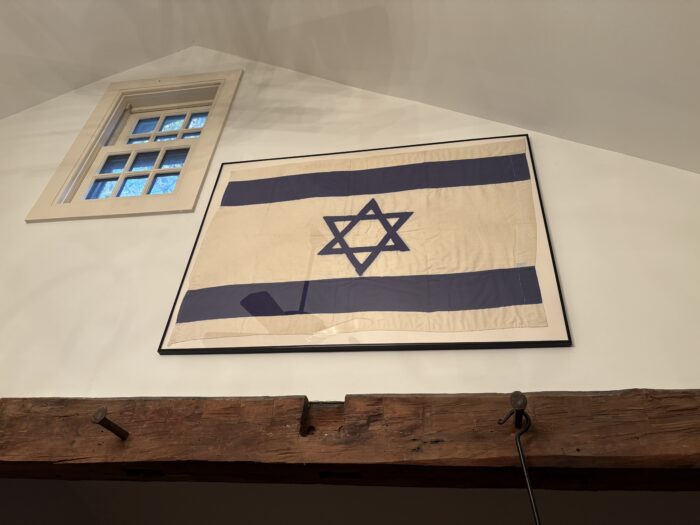He’s home
This is me interviewing Dani Miran, father of hostage Omri Miran, in Hostages Square for our documentary The Campaign. Omri was in the first group of hostages released. So happy for his Dad.

Free
New one, finished the morning of the hostages’ release. Dark skies have light.

Yanks
Someone observed that I wrote more about Trump 1 than Trump 2.
Me: “The first time I thought it was the exception, not the rule. I thought they’d reclaim sanity.
I can’t read or listen to them anymore. They demanded crucifixion and now they complain about the view.”
Elbows missing
In politics, as in hockey, “elbows down” can have unhelpful consequences.
You can get hit more, for example. Lots more bruises and missing teeth, too.
A quick 2025 refresher, for those who don’t remember: Justin Trudeau leaves, Donald Trump arrives, 51st state, Pierre Poilievre collapses, Mark Carney appears.
And Carney – who had never run for high public office before, had never chaired a cabinet meeting, had never participated in televised leaders’ debate – did better than anyone (especially Poilievre) expected. But he had a secret weapon, didn’t he? Carney had two words that made him Prime Minister, and saved the Liberal Party of Canada from a fourth-place finish in the election.
“Elbows up.”
The Liberals bet the house on those two words, and it paid off, big time. They put them in online ads. They put them in speeches. They put them in ads, and ran them over and over and over, featuring Carney and beloved Canadian ex-pat Mike Myers at a hockey rink, somewhere in Anytown, Canada.
The scene: Myers looks surprised to run into a Prime Minister at a hockey rink. Carney asks if Myers lives in the States. Myers says yes, but adds that “I’ll always be Canadian.” Skeptical, Carney then quizzes him on Mr. Dressup, Howie Meeker, Saskatchewan’s capital, Toronto’s seasons and the Tragically Hip. Myers gets them all.
“Wow,” says Carney, smiling the smile he reserves for those love-sick moments when he actually calls Trump a “transformative” president. “You really are Canadian.”
Myers: “But let me ask you, Mr. Prime Minister, will there always be a Canada?”
Carney: “There will always be a Canada!”
Myers: “All right! Elbows up!” Carney says it, too, and then they (weirdly, this isn’t the pandemic anymore, fellas) touch elbows.
Thusly, “elbows up” elected Mark Carney Prime Minister, kept the Grits in power, and defeated Pierre Poilievre in the election and his own seat. Two words did all that. Impressive.
[To read more, subscribe here]
Am Yisrael Chai
Got this for my birthday from one of my oldest friends. This hand-sewn Israeli flag apparently flew near a peacekeeping mission in the Middle East decades ago.
Seems fitting to get it up on the highest wall in my place, particularly this week.

Peace, and the consequences of peace
First things first: Donald Trump deserves lots of credit. Even Trump critics like this writer agree.
On the second anniversary of October 7, I spoke at a vigil for the hostages still held by Hamas. Unsurprisingly, some of the Jews present kibbutzed with me about the rumoured coming peace deal. I asked them whether Trump could pull it off.
One woman summed it up perfectly. “I’m no fan of Donald Trump, like you,” she said. “He’s a bit crazy. But this is a situation where his craziness helps – Hamas obviously feels he’s crazy enough to wipe them out!”
We laughed, but that was – and remains – the key question: will Donald Trump’s peace deal result in the eradication of Hamas? Because make no mistake: Hamas is the biggest impediment to lasting peace in the Middle East. Israel, and every surrounding Arab nation agree on that.
Given that, what does the future hold? What challenges lie ahead, for Trump and the rest of the world? There are five main ones.
The Propaganda War. I’ve written a book about this subject, titled The Hidden Hand, and it’s out in February. One thing that is indisputable: the anti-Israel, anti-West propaganda campaign – overseen by Iran, funded by Qatar and assorted anti-Israel charities and NGOs, and staffed by Hamas and its axis – is not going away, peace or no peace.
The antisemitic, anti-Israel information war has been wildly successful for Hamas and its cabal – far beyond their own expectations, in fact. Just this week, Harvard-Harris released a poll showing nearly half of young Americans fully support Hamas over Israel. And, online and in the streets – and in academia, government and public sector unions – Israel is losing, or has lost, the information battle. The antisemitism we see everywhere is unlikely to disappear anytime soon.
The Governance of Gaza. There is a reason why no surrounding Arab nations ever took on Palestinian refugees – and why Egypt even built a wall bordering Southern Gaza that was impenetrable: stable Arab states regard Gaza, and Palestinians, as completely ungovernable. So who is going to run the Gaza Strip, if the Palestinian Authority can’t, and Hamas shouldn’t?
For the likes of Canada’s Mark Carney, France’s Emmanuel Macron and Britain’s Keir Starmer, answering that question is very politically perilous. Those three, and others, recently recognized the state of Palestine and made grandiose pledges to pay for its reconstruction and rehabilitation. There will be a steep dollar cost for that, which Canadian taxpayers are unlikely to appreciate. And, if Carney makes good on speculation that Canadian troops could be sent to Gaza to keep the “peace,” what happens when some of them inevitably become casualties?
Words are cheap. Messrs. Carney, Macron and Starmer may soon regret theirs.
[To read more, subscribe here]
“Ceasefire now.” Right.
The first casualty of war…you know the rest.
“Truth is the first casualty of war.”
Of course.
Everyone knows that one. You hear it all the time. But – good God Almighty – that latest Harvard-Harris poll: there perhaps has never been better evidence of the war-murders-truth proposition, perhaps ever. Not even since the Greek playwright Aeschylus wrote those words, some 3,000 years ago.
The Harvard-Harris survey landed on our computer screens on October 7, and was issued by the university’s respected Center for American Political Studies. Nearly 2,500 registered voters were contacted at the start of the month, and the results are considered to be accurate 95 per cent of the time. The poll covered the mood of the country, Trump, economy, jobs, and so on.
It was the answers to the “Israel and Gaza” questions, however, that were – and this word is used too much by those of us in the media, but it applies in this case – shocking. Really, truly shocking.
The Harvard-Harris numbers can’t be easily dismissed, either, international law expert Elliot Malin noted, because Harvard-Harris is “consistently been the only pollster asking questions on Israel-Hamas over the last two years.” So they have what pollsters like to call a “baseline” or “benchmark,” and are therefore much more accurate.
Here is a sampling of what Harvard-Harris found:
- Nearly half of Gen Z – those from ages 18 to 24 – support Hamas over Israel. Almost 40 per cent of Millennials – ages 25 to 34 – support the terror group over Israel.
- Over 40 per cent of Gen Z oppose Hamas releasing the hostages they took on October 7, 2023. A third of Millennials feel the same way.
- Over 60 per cent of Gen Z oppose Trump’s peace plan, which is supported by every Arab nation in the region, and just about every country on Earth. Nearly 50 per cent of Millennials oppose the peace plan.
- Sixty per cent of Gen Z falsely believe Israel has actually rejected Trump’s peace plan. And 45 per cent of Millennials have somehow concluded the same thing.
- Forty per cent of Gen Z think Hamas should reject the peace plan. And almost 30 per cent want Israel “ended,” and power simply handed over to Hamas/Palestinians.
[To read more, subscribe here]
October 7, today
Today, on October 7, any Jews gathering in public are taking a risk. Because it is dangerous.
It is sad, and disgusting, and shocking, that that is the case. But that is the reality for Jews across the West on this day, October 7, 2025.
Many Jews will still come together in public, just the same. For them, doing so is also an important act of defiance.
Why? Because, on this day – the worst days for Jews since the Holocaust – coming together, gathering, is an important symbol of unity on a solemn day of remembrance. It’s an expression of unity.
After Manchester – after Washington DC, after Minneapolis, after Boulder, Colorado, after too many lives lost in too many other places – everyone knows there is a risk, no matter how remote, in gathering in public on this day. There is a risk of bodily harm, or worse.
At Concordia University in Montreal, at the University of Toronto, hateful people – some students, some not – have put up posters to celebrate their “martyrs.” To celebrate the death cult that is Hamas.
That is why Canada in October 2025 has become not unlike Berlin in 1935: killers are being praised, and a religious minority being demonized. But standing with our Jewish brothers and sisters – supporting them on this day, of all days – is something we must do. We must.
We, Jew and non-Jew alike, must show our commitment to civilization. To decency. To humanity. To each other.
We must show our opposition to the beast of antisemitism and hate, which is now everywhere to be seen. We must fight back.
We do that, of course, by always remembering the hostages, and calling for their release. We do that by remembering those we have lost on October 7 and on the days since. We do that by pushing back against the rising black tide of antisemitism and hatred.
We do that by simply being here together, and saying: you, the haters, will not cancel us. You will not silence us. You will not replace us.
Truly: October 7 was one of the darkest days of our lifetimes. Words alone cannot describe it.
So, October 7 places an obligation on the shoulders of all of us. It requires us to remember the men, women and children who had life taken from them by monsters in the shape of men – and it requires us to ensure that it never, ever happens again.
We do that in many ways. We do that by gathering together on this day, to say:
We will defy the haters. We will defeat them. The Jewish people have been here for thousands of years – and the Jewish people will be here for thousands of years to come.
As Dr. Martin Luther King, another proud Christian Zionist, said: “Darkness cannot drive out darkness. Only light can do that. Hate cannot drive out hate. Only love can do that.”
We have love, and humanity and civilization on our side. We have decency and and the truth on our side.
And with those things, the forces of hate will never, ever defeat us.
[A version of these remarks were used by Kinsella at an October 7 vigil in Belleville, Ont. today.]
